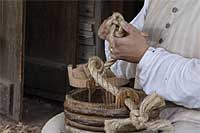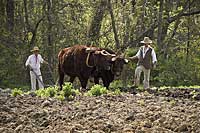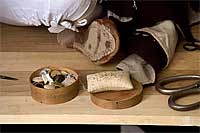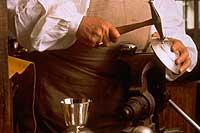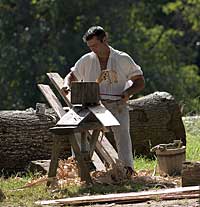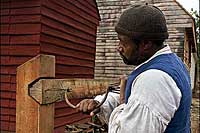Page content
Many trades assist rural colonial Virginians
Artisans played a vital role on the plantations, farms, and in rural communities surrounding Williamsburg. There they concentrated in the trades most useful to agricultural communities. They constructed houses, tobacco barns, smaller outbuildings, and fences, and made utilitarian furniture for rural households. They made the wooden containers in which tobacco, the lifeblood of the Chesapeake economy, was shipped overseas, and the “dry” and “wet” (water tight) casks in which corn and alcohol were stored, and a host of other practical wooden farm and kitchen utensils. They made and repaired the metal hoes, axes, plows, and plow gear required for farming, and built carts and wagons for hauling goods and produce from field to market. Tanners processed hides from locally slaughtered animals, while shoemakers and tailors made footwear and clothing for both free families and for enslaved and indentured servant workers.
Without these trade skills, people in rural communities would be forced to buy often scarce and expensive imported goods, do without, or improvise as best they could on their own. However, within a few years of initial settlement, colonists adapted Old World patterns for supplying goods and services to the realities of the New World environment. They continued to import manufactures which local craftsmen could not produce or which, like mass produced pottery, gloves, and hats, could be bought cheaper from abroad than locally produced wares. But they also employed a large number of local craftsmen to make basic necessities and a few amenities that could more easily be supplied by making use of locally available natural resources.
Life of the rural craftsmen
Craftsmen settled on plantations they owned or rented, scattered among neighbors who supplied many of the raw materials for their trades and who employed them to make utilitarian household and farming implements.
In the 18th century, small planters combined farming with occasional craft work. Large slave holders more often had enslaved workers trained as rough carpenters, coopers, and shoemakers in order to make their plantations more self sufficient. Consequently, in the 18th century, most rural artisans had been born in the colony and often in the neighborhoods where they lived and worked. These rural artisans were linked to their customers by ties of kinship and long acquaintance. In contrast, many of the craftsmen pursuing luxury trades in Chesapeake towns immigrated there from Europe or from urban centers in other colonies. While townspeople were willing to pay a premium for upscale goods made according to the latest metropolitan fashions, most country folk were more interested in obtaining inexpensive, durable goods adapted to local needs.
The small size of rural markets prevented many rural artisans from supporting themselves entirely through craft work. Most rural artisans kept animals, raised corn, vegetables, and fruits for food, and often planted tobacco. However, an artisan who supplemented craft work with food crops and raising livestock considered himself a craftsman and defined himself in public documents by the skill he practiced. In contrast, householders who occasionally did some carpentry or made a few pairs of shoes, but who gained most of their income from raising tobacco, thought of themselves as planters.
Rural trades involved generalized skills
Limited markets also promoted craft generalization rather than specialization. Rural artisans worked consistently using one specific raw material such as wood, metal, or leather. But they worked broadly among the trades using that resource. Tanners, for example, often made shoes; carpenters might also make furniture, casks, wooden tools and eating utensils, and fences as well as barns and dwellings. Because of the limited demand for their services, most rural artisans did not have workshops in which journeymen or indentured servants learned the master’s trade. However, many clearly trained their children, and others trained enslaved men and boys at the request of large neighboring planters. The county courts also apprenticed poor orphans to rural craftsmen so that they might learn a trade by which they could later support themselves.
Trades such as carpentry, coopering, shoemaking, and tailoring did not require expensive equipment and were therefore economically more inviting than tanning and blacksmithing. These trades required higher levels of capital investment in tools and raw materials, thus limiting the number of people who entered into this work. In order to complete large projects such as building ships, churches, or bridges, or for supplying large orders for raw materials, rural artisans sometimes worked in partnership.
Specialized artisans lived in towns
Townspeople needed similar goods and services as country artisans provided, but they also supplied a concentrated market for specialized luxury craftsmen such as silversmiths, watchmakers, coach makers, cabinetmakers, wigmakers, and milliners. These specialized artisans seldom lived in rural areas, as they needed concentrated town markets with higher proportions of affluent customers. Butchers, bakers, and brewers were also concentrated primarily in towns because rural households processed foods themselves.
In the countryside, woodworkers accounted for at least half of all self identified craftspeople. Carpenters were most numerous, followed by coopers and sawyers. Next came the cloth workers (primarily tailors), roughly 15 percent of craftspeople, followed by leatherworkers (predominantly shoemakers), about 10 percent of artisans, and blacksmiths, about 5 percent. A few other specialized artisans such as millwrights, ship carpenters, and bricklayers also sometimes found a niche for making a living in rural areas.
Wives and daughters of planters, tenant farmers, and rural artisans made much of the clothing household members wore and they often earned extra money from sewing, knitting, spinning. Only women living in towns advertised their skills in newspapers, or took in orphan apprentices, or identified themselves in public documents by their trades.
The enslaved in rural trades
In the 18th century, enslaved carpenters and coopers were often hired out by their rural owners to work on neighboring plantations, and enslaved shoemakers and blacksmiths, when not making goods for their masters, often did custom work for entire rural neighborhoods. Black craftsmen always worked under the supervision of a white artisan or contractor when employed on large projects such as building barns, houses, or churches.
Colonial Williamsburg’s 21st-century craftsmen
Today, visitors to Colonial Williamsburg’s Historic Area can see craftsmen pursuing many of the trades common to both town and country. Sawyers cut timber and carpenters construct and repair outbuildings and fences using traditional 18th-century methods. Coopers make a variety of practical wooden containers, ranging from huge casks large enough to hold 1,000 pounds of tobacco, to water buckets and small food storage containers. Historic Area shoemakers produce practical and fashionable footwear. It was goods such as these that were essential to the colonial economy in rural areas and towns.
Learn more:

